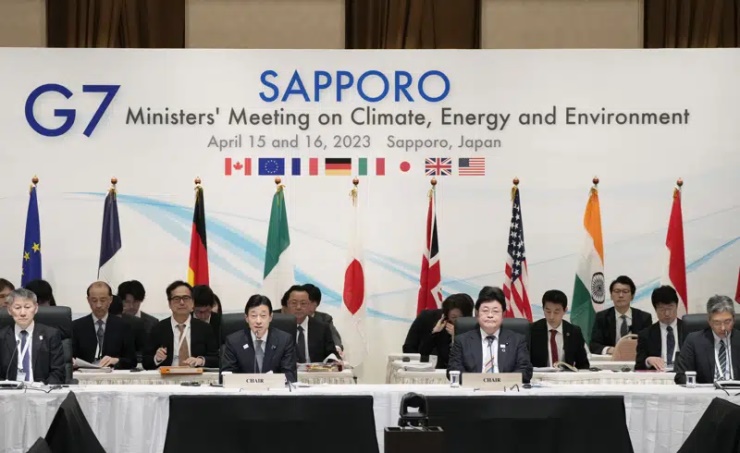Sapporo, April 15 (BNA): Energy and environment ministers from the Group of Seven rich countries met on Saturday in northern Japan, seeking to reconcile the world’s heavy dependence on fossil fuels with the need to end carbon emissions to stave off the worst consequences. Climate change.
The meetings in the northern Japanese city of Sapporo aim to reach consensus on the best way forward, ahead of the G7 summit in Hiroshima in May, the Associated Press (AP) reports.
“We are faced with the challenge of promoting reforms to solve the problem of climate change … while achieving energy security,” Economy Minister Yasutoshi Nishimura told the ministers as the meetings began.
Speaking on the sidelines of the meetings, US presidential climate envoy John Kerry said the G7 is “in a strong position to lead” in efforts to stop global warming. “We appreciate Japan’s leadership and leadership of the G7 this year.”
But disagreements persist over how and quickly to end carbon emissions, especially at a time when the war in Ukraine has deepened concerns about energy security, complicating the effort.
The talks in Sapporo will also focus on biodiversity loss and other global challenges. But climate change is high on the agenda for closed-door meetings. At last year’s G7 summit in Germany, the countries set a common goal of achieving a fully or mostly carbon-neutral electric supply by 2035.
US officials have expressed support for Japan’s strategy that focuses on so-called clean coal, hydrogen and nuclear power to bridge the transition to renewable energy. Others are pushing for a faster transition to renewable energy.
The head of the United Nations recently called for an end to drilling for new fossil fuels and for rich countries to stop using coal, oil and gas by 2040. And while emissions among G-7 countries, especially in Europe, are beginning to fall, they are still there. Globally, particularly in large and increasingly affluent economies such as India and China.
US Energy Secretary Jennifer Granholm said in an interview Friday with The Associated Press that the G7 nations hope to lead by example.
She said, “We expect those countries to see that this can be done and the countries that have sufficient capabilities to make these investments to be the first to give hope to others to be able to do so because technology reduces the cost.”
The US government’s approval of fossil fuel initiatives such as the Willow Project on Alaska’s oil-rich North Slope has drawn criticism for its environmental impact and for contradicting President Joe Biden’s pledges to cut carbon emissions and transition to clean energy.
There is a strong business case for climate-friendly policies, Granholm said, given the estimated $23 trillion global market in clean energy by 2030.
People see people getting jobs in this area. People who start driving electric cars and don’t need to pay petrol prices know that driving electric vehicles is much cheaper. she said while touring the Suiso Frontier, the world’s first and only liquid hydrogen carrier, a showcase of the latest technology for what Japan’s leaders call the “Hydrogen Society.”
While Japan’s fields are increasingly planted with solar panels instead of crops and its windy coastline abounds with wind turbines, the country still expects about 60% of its energy to come from fossil fuels in 2030, with renewables accounting for up to 38%. New fuels and nuclear power will handle the rest.
Meanwhile, Japan is striving to protect communities from extreme weather and other effects of global warming. It has become the habit of hot summers, torrential rains causing floods and landslides, and violent storms.
In Sapporo, Japan is seeking endorsement of its so-called “GX Transformation” plan, which its leaders say is designed to boost energy efficiency and phase out carbon emissions that contribute to global warming.
The unenacted legislation would require a 20 trillion yen ($150 billion) bond issue to help attract 150 trillion yen ($1.1 trillion) of public-private joint investment in decarbonization. The law also calls for a carbon pricing system to make companies pay for their carbon emissions.
Environmental activists say the plan would keep the country’s dwindling nuclear industry on life support while undermining the shift to renewables.
said Takejiro Suyoshi, co-representative of the Japan Climate Initiative, a non-governmental organization with 768 member companies and organizations.
Debates have slipped away in Japan as if we were in the twentieth century. We must break a wedge in the debate to drive it forward, not backward,” he said.
The Joint Commission International urged officials meeting in Sapporo to push for more ambitious targets, noting that Canada, Germany, the United Kingdom and Italy already get more electricity from renewable sources than Japan’s 2030 target and that despite faltering progress toward phasing out fossils, . Fuel, the United States will get most of its electricity from renewable energy by 2035.
“There is no time left. The window for change is closing, but there is still hope. We need to use the sense of crisis as a turning point,” Suyoshi said.
The G7 includes Canada, France, Germany, Italy, Japan, the United States and the United Kingdom.
M
